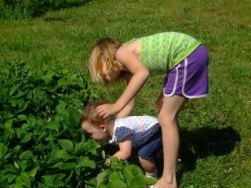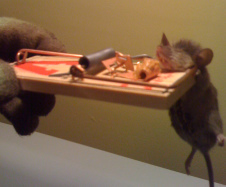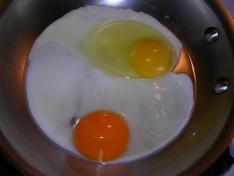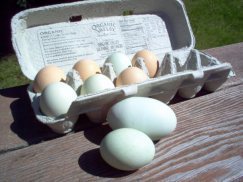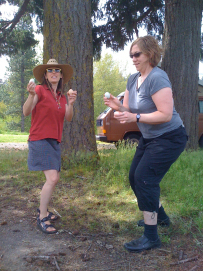Kristy Athens's Blog, page 15
May 27, 2012
Ladies and Gentlemen, Start Your Engines
This was a very exciting week! It actually started May 15, when I drove out to my old stomping grounds in the Columbia River Gorge to début Get Your Pitchfork On! Suzanne and Aaron opened their fantastic restaurant, Solstice Wood Fire Café, just so Waucoma Books could host an event there! (And I’m not just calling them fantastic because they are nice to me; they’ve recently been recognized by via magazine and Portland Monthly.) The place filled with dozens of old friends, and a couple new ones, and I went to sleep that night with a big smile on my face.
Monday an interview with me was posted to “Seven Questions,” which features a different author every week. I was really impressed with Laura Stanfill; she had clearly not just read the book but also done a bunch of research.
On Tuesday morning, I went to KATU, Portland’s Channel 2 television station, to appear on AM Northwest. I shared the green room with a young woman who is launching a career as a vegan chef and two guys who are touring as impersonators of Elvis and Jerry Lee Lewis. The hosts, Helen and Dave, and their staff were extremely accommodating and welcoming, and the interview went too fast! Next time I’m asked, I will simply say that I grew up “in the Midwest.”
Wednesday, I lived like an ordinary person and went to work. I do have a day job, as office manager of Oregon Humanities. My colleagues are extremely supportive of this little summer side-job. Thank you, Cara, Carole, Kathleen, Jennifer, Kamla, Annie, Sarah, Eloise and Alicia!
Thursday I reported to the Powell’s on Southeast Hawthorne for my first Portland appearance. The store expected 20 to 30 people and got a big surprise when at least 60 crammed themselves into every aisle in the store! I was pleased to meet “Seven Questions” blogger Laura in person, as well as Gregg Einhorn, the book’s designer.
I didn’t realize that the excerpts I chose to read were all kind of violent and depressing (cats getting eaten by predators, people accidentally cutting their hands open and getting arms torn off by farm machinery) until I was reading them. By the end, I felt sort of guilty. But the truth hurts—country life can be dangerous! Everyone looked like they were having a good time regardless—I just hope the children in the audience weren’t listening very carefully …
After the reading, friends wandered across the street to Nick’s Coney Island, whose friendly staff were waiting for us with cow-spotted balloons and a signature drink—The Pitchfork! It’s what I often drink at home: bourbon and grapefruit-flavored bitters. Carrie, one of the owners, emailed me a few days later and said that they plan to add The Pitchfork to their regular drink menu—so go in and ask for one by name!
Saturday, Mike and I packed the car and took off for Southern Oregon, where I arranged to sign books at Quady North Winery in Jacksonville. I enjoyed meeting people from all over Oregon and California, especially the owners and tasting room manager of the winery. Thanks for having me, Herb, Melanie and Emily!
Then we drove to nearby Applegate, home of friends Chelsea and Tyler—the very people who suggested I send the Get Your Pitchfork On! manuscript to Process Media. Visiting them is always an adventure—this time it was a prom-themed party. Pretty entertaining to see a bunch of 30- and 40-somethings carrying on in tuxedos and fancy dresses! Keep the tulle away from the bonfire …
There are more surprises in store next week and, in mid-June, I embark on a week-long tour of Eastern Oregon. At the end of June, I will hopefully reprise the standing-room-only experience at Portland’s Broadway Books. Stay tuned!

May 20, 2012
Raspberry Mystery!
In my 43 years, I have lived in a number of different homes—fifteen, in fact. As an adult it’s always been a thrill, that first spring in a new house, because I have no idea what is going to come out of the ground. Especially the two homes I have owned rather than rented. All those plants are mine! Landscape and garden plants are the icing on the new-house cake.
My friend, Annie, and her husband, Aaron, bought a house in February, so for the last two months the treasure trove in their yard has been revealing itself. The catch—neither of them is a gardener, and they don’t know what they’re looking at. What is a plant and what is a weed? They want to learn, though, so one Saturday in April I stopped by.
As Annie pointed out the different corners of the yard, she thrilled and panicked with the growth that had occurred. “The sun came out, and everything grew a foot!” she said.
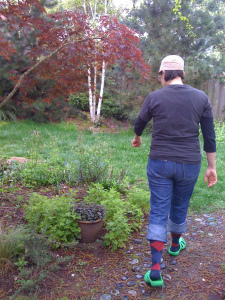
Annie gives me a tour
A previous owner had transformed what had been a regular American grass lawn into front-and-backyard oases featuring rounded, organically shaped beds lined with paths made of glass bottles that she pounded upside-down into the ground. The aesthetic was clearly one of blending the plantings as much as possible—while there are three boxy raised beds in the front yard, the blueberry bushes, rhubarb, kiwi and raspberries are all intermixed with the rest of the landscape. A spindly, 10-foot-tall fig tree was up against the fence, wedged between a stand of bamboo and a rhododendron.
“The good news is that this is a fig tree,” I said, pointing to it. “The bad news is you will never see a fruit on that thing; it’s way too stressed out.”
I pointed out how relocating some of the pine needles would benefit the acid-loving rhododendrons and blueberries. I suggested she dig out most of the compost that had seasoned in a barrel but save a few shovels full to get the new batch going. I confirmed her suspicion that the kiwi vine was supposed to be following the trellis and not shooting 20 feet into the air.

Errant kiwifruit vine
The main reason Annie wanted my advice was for the raspberries. They had been planted next to the garage, and everything Annie had read about raspberries suggested they needed some kind of support.
When I looked at them, I wasn’t sure what to think. They were certainly berry plants. They even looked like raspberry plants, but the canes were only 6 inches tall. Most had new growth, but because the canes were so short the plants were only a foot high. There were only a few new shoots coming out of the ground.
Raspberries usually grow in a two-year cycle. The canes that grow in Year One do not flower; they should end up 5 to 6 feet tall, or more, leaning over from their weight. Once winter ends, you trim them back to about 3 to 4 feet tall and thin them if necessary. Year Two plants grow from the ground. The new growth on Year One canes ends in berry blossoms, and then berries. Once the berries are picked the canes die out, and you cut them out of there before winter.

Mysterious plant
What I was looking at was, upon close inspection, definitely second-year canes. But they were so short! And then there was the matter of not having any support in place for them.
Investigating someone else’s garden made me feel a little like a forensics specialist. I had to observe the evidence and then consider motives—were these “everbearing” raspberries? Were they some other kind of berry altogether? I voiced my ideas aloud to Annie, my Watson.
After floating a few hypotheses, I presented my final answer: The previous owner trimmed the canes back severely in order to stunt their height, so that she didn’t have to put in supports.
I have never seen anyone do this before; time will tell whether that works or whether they’ll just be stunted plants. I instructed Annie to leave them alone, and look forward to hearing how they behave as summer rolls along. There’s always next year!

May 13, 2012
GYPO Podcast
Short post this week: Listen to Growing Your Grub podcast!
I had the pleasure on Tuesday of speaking with Steve Howard, a retired technology guy who has a couple of podcast programs all having to do with country living. Steve is in the process of pulling up the tent stakes and moving to acreage he and his wife purchased in Northern California. So, he was very interested in Get Your Pitchfork On!
I appreciated the close reading he gave my book. I felt that he got it—he described it perfectly, as somewhere between a how-to and memoir. We had a great conversation. You’ll hear stories that didn’t make it into the book, and background to stories that did.

May 6, 2012
Sustainability Champion
Reading the community notices on a Portland nonprofit’s bulletin board, I saw an ad for the
“Tod LeFevre Gorge Sustainability Awards.” Odd, I thought. Tod LeFevre was in his late forties, an engineer who lived in the Gorge and taught a series of sustainable-energy classes with the community education service. I had taken those classes in 2005 to learn about improving our seven acres with solar, wind and/or water power.
Tod was his own little power station, buzzing with energy at the evening classes even though he, like the rest of us who were swilling coffee to stay awake, had worked a full day. He had a bunch of print-outs for us to take home, ran a PowerPoint he had created, and ad-libbed extensively and enthusiastically from his notes.
Tod had built a net-zero house in Colorado somewhere in the late 1990s, and then sold it and moved to the Columbia River Gorge with his wife. They converted their house in Hood River to net-zero-or-close-to-it by adding solar panels and making other adjustments. Understanding and limiting electricity draw is a major factor in living with sustainable energy—as he demonstrated how to track household energy use, he presented his own home as a model. For example, you typically can’t run the dishwasher and the clothes dryer at the same time.
“So,” he illustrated, “if you run your vacuum about an hour a week …” I thought, Hm—I run my vacuum about once a month. On top of everything else, his house is immaculate??
A tireless advocate of sustainable energy, Tod fought for a number of local municipal projects, including solar panels that were installed at the school in the town of Mosier. He was the kind of guy who persevered by winning people over, not just advocating for ideas.
So I was pretty shocked to read that the Tod LeFevre Gorge Sustainability Awards were in memoriam. Unbeknownst to me, Tod suffered from pulmonary fibrosis and died in March 2011, before donor lungs could be found.
Though a year late, I am lamenting the passing of a bright bulb—lit by sustainable energy!

April 29, 2012
Country Gifts
When invited over to a friend’s house for dinner, what do you usually bring for the host? A bottle of wine? I don’t know about you, but as I’ve aged my tastes have become more refined, which means I can no longer choke down “three-buck Chuck.” Which also means that I feel uncomfortable bringing cheap wine as a gift. Which, of course, means that I’m spending at least $15 on a good bottle every time I go to someone’s house.
That can add up!
Consider a country alternative—bring some jam that you made! I used to buy half-pint jars for that purpose, so I didn’t lose the super-thick old-school jars that my friend Catherine mailed to me from her grandmother’s house. Easier than asking for your good jar back.
Another country gift: I used to saw an egg carton in half with my bread knife and pack six eggs. Since we had Ameraucanas and Barred Rocks, our friends received beautiful green and brown eggs. You can make it fancier by tying some ribbon around it.
Be sure that you are not casting your pearls to swine—only give a lovely country gift to someone who will appreciate (and eat) it. Before Mike and I lived in the country, a friend once brought us a jar of plums she had canned. We were afraid to eat them, thinking them somehow suspicious and unsafe. Once I brought one of my little egg-gifts to a friend’s house, and I could tell immediately that she was afraid of them.
“How long will they stay good?” she asked, eying the carton carefully.
“Weeks,” I assured her. “Those are way fresher than any you’d buy in a store.”
I knew she would never eat them. Oh, well. Sacrificial eggs. Other friends would squeal with delight.
So—give your magical country gifts to people who will appreciate them, and save some money on store-bought treats!








April 22, 2012
Trellis
Last weekend I met my family at my cousin Bill’s house because his sister, Betsy, was visiting from Rhode Island. As Bill poured wine and Betsy and my parents chatted, Bill’s partner Jessica asked if I could help her with the garden. We walked outside, accompanied by six-year-old Owen, and she pointed out the young bean plants in a garden bed next to the garage. Jessica had purchased a package of six four-foot bamboo stakes from a garden store but wasn’t sure how to arrange them.
The purpose of a trellis is to support a growing plant. Beans and other legumes are designed to climb; they develop tendrils that are deceptively strong. The tendrils reach out until they make contact with something and wrap around it, giving the plant a leg up toward that open sky and sunshine. Since people plant garden vegetables in isolation to guarantee they (and not weeds or competing vegetables) receive the nutrients, we have to provide something for them to cling to.
Owen weighed in with a teepee design for each plant, which really wasn’t very far off. The bean plants were in two short rows of three, so we stuck a stake next to each, about a foot deep. Then, we bowed each stake over to its mate on the other side and tied them together. I pointed out that the knot would be more stable if Jessica wrapped it over-and-under, rather than side to side, and that a small, tight knot was more important than wrapping it around and around a bunch of times. Twine stretches, and once it rained the knots would loosen a bit.
Owen ran off and returned with another length of bamboo, which he offered as something to run across the top to help stabilize the entirety. Jessica and I lashed it above the joints we had created.
“Look, it makes a tunnel that you could crawl through!” Jessica observed. “Wait, that’s not such a great idea—did I say that?” We laughed. Owen is not the kind of kid who needs encouragement to run roughshod over things.
Near ground-level on either side, I showed Jessica how to run lengths of twine from one end of the trellis to the other, tying on at each stake—above the bamboo joint, if possible. Bamboo grows in segments, and at each new segment there is a little “knuckle” which is a great place to support the knotted-on twine. Near the bottom, it’s also helpful to run additional twine up and down from each length of twine—because the beans plants are young and small their tendrils are short.
Once the plants latch on to the trellis they take off like wildfire, but at first they need a little extra help. Just like gardeners.

April 15, 2012
Epsom Salt: Your New Best Friend
How did I circle the sun 43 times before I learned to appreciate Epsom salt?
I’d always been a bubble bath gal. As kids, my sister and I never got the coveted Mr. Bubble because my mom was an Avon Lady—ours came in a nondescript, tall bottle with rounded bumps along the sides. The soap was pink, at least.
I thought that a bubble bath was the only kind of bath one could have. I’d heard of Epsom salt but it seemed like one of those old-fashioned things people used to do, like take castor oil. Anyone on television who was bathing was always covered in rich lather. It never occurred to me that this was done solely to make it possible to have a naked woman on prime time TV.
I hadn’t taken many baths as an adult; I’m only 5’3” but even my tiny frame barely fits in a shower-insert tub, so it didn’t seem worth the trouble. However, the house Mike and I currently rent has a big ol’ claw foot tub, so I’ve been trying to take advantage while we’re here. I have to give Mike credit; he bought a bottle of bubble bath from the organic section of our grocery store (after first considering Mr. Bubble!) and poured my inaugural bath.
It wasn’t until some friends gave me a jar of “bath salts” for my birthday about ten years ago that I was even aware of such a thing. I was suspicious of it, and my doubts were confirmed when I dumped a bunch of the powder into the bath. No bubbles. What was the point? It smelled good, at least.
But bath salts are not Epsom salt, which isn’t salt at all. Originally extracted in the English town Epsom, magnesium sulfate is a special combination of minerals that soothes muscles, improves circulation and moisturizes your skin. It even has nutritional value, for crying out loud.
I went skiing on a weekend in March, and the following Monday was totally wrecked. My legs were sore, of course, but the pain in my shoulders was creeping into my neck and threatening to immobilize my head. I happened to have recently purchased a package of Epsom salt, intending to find out what it was all about. It is about MAGIC, dear readers! Two cups in a warm bath, and my neck and shoulders unclenched completely. My quadriceps were still sore on Tuesday, but I was no longer walking like Frankenstein.
It may be hard to give up the aesthetic appeal of a bubble bath. There are even bubbles in the bath on the official Epsom Salt Council website! But after a day of bucking hay or digging garden beds, you are going to very pleased I introduced you to your new best friend, Epsom salt.

April 8, 2012
K&M Wellness Retreat
In the fall of 2002, my friend Jane (one of two best friends since fourth grade), called me with hilarious news: her husband, Keith, had been diagnosed with skin cancer. Even more ridiculous: the doctor had given him five years to live. Five years? Hysterical. It’s just skin cancer—my grandma gets bits of it cut out of her face all the time.
We laughed because it was so absurd. We laughed because we were in our early thirties, and those things simply did not happen. Not to a healthy, active guy with two young daughters. Someone might die in a car accident, or maybe even commit suicide. But cancer? No way.
After we learned that there were two kinds of skin cancer, and Keith had The Bad Kind, we stopped laughing so much. In 2003, while Keith was enduring chemotherapy, radiation, surgeries and skin grafts, Mike and I bought our farm in the Columbia River Gorge. We traveled to Minnesota to visit them that December. I brought freshly smoked Pacific salmon, which Keith couldn’t enjoy because his surgeries and medications had destroyed his sense of taste.
In the spring Keith was in bad shape, but still fighting and still optimistic. He and Jane pulled out all the stops: In addition to working with oncologists and surgeons at the Mayo Clinic, they visited nutritionists and spiritual healers. They traveled to New York to visit a well-known naturopathic physician who specialized in cancer patients. Part of his treatment regimen included coffee enemas.
I really wanted them to come out to Washington for a visit. I felt like our place had been so wonderful for Mike and me that it would serve them equally well. “Come to the K&M Wellness Retreat,” I wrote to Keith, “where you’ll enjoy beautiful views, fresh eggs in the morning, and coffee—however you take it!”
Unfortunately, Keith couldn’t suspend his treatments long enough to come out. He died the following spring. Not five years after his diagnosis, just eighteen months. At the end of May, Jane brought her girls out. She was exhausted, and more than ready for the K&M Wellness Retreat.
I bought rubber “farm boots” for Claire, who had just turned five, and Amelia, two. Mike took the girls on hikes through the fields and woods. Claire learned to whistle, and Amelia learned to push stalks of wheat, like little piñatas, through the fence of the chickens’ enclosure, where they would go crazy fighting over the kernels. Jane rested and stared at the mountains that surrounded our house. We planted a pear tree along with some of Keith’s ashes.
Claire whistles
In 2008, Jane, Claire and Amelia returned to our farm—with Jane’s new husband, Scott, his daughters Meghan and Morgan, and their new baby, Joanna. Claire and Megan tried Mike’s guitar. Amelia reacquainted herself with the chickens. Morgan enjoyed the swing chairs in the garden house. Baby Jo launched herself from one interesting thing to the next, making sure that the strawberry patch was part of her route. Jane and Scott relaxed and stared at the mountains that surrounded our house.
Baby Jo and Amelia pick strawberries
Things had come full circle at the K&M Wellness Retreat.

April 1, 2012
Got Mouse?
WARNING: This blog post includes a photo of a dead mouse.
Damn it, the things are so cute! Skittering here and there; scuttling under the refrigerator and behind the garbage can. But they can’t live in your house. Mice are adorable, germy, flea-carrying disease nubbins that poop and pee everywhere they go. You can’t have it.
“Mouse!” Mike just yelled. He wasn’t yelling to me; he was yelling to the mouse that had run toward us from the kitchen. We both talk to animals directly, and call them their species names unless we know their human names. “Crow!” “Chickens!” “Horse.”
“You can’t be so bold,” Mike told the mouse, which had scurried out of sight. “You can’t live here.”
I got out the mousetraps and laid them on a paper towel. Three had been under the sink, untouched, surrounded by mouse poops. Two were lying in the corner near the door, where each had been kicked from in front of the stove when Mike or I accidentally nicked it with our shoe and set it off. (Unexpected tripping of mousetraps may lead to you poop and pee wherever you go, as well.)
I dug the stale peanut butter from the levers with a toothpick and replaced it. You don’t need a lot of peanut butter; in fact, if you use too much the mouse can eat some of it without ever hitting the lever. I set the traps and put one back under the sink, one in front of the stove (which Mike will doubtless set off tomorrow morning when he’s making coffee), one behind the garbage can and two in front of the refrigerator, where the mouse had taken refuge. Each was set against and perpendicular to the baseboard, as mice generally travel along the walls—at least until they become so comfortable with their surroundings that they run straight into the dining room, as this mouse had so recently done.
I have never had luck with anything but the old-fashioned wooden traps with the metal lever and bar. I tried similar traps that had fake plastic cheese as a lever, but they wouldn’t stay set. Many years ago, I got these big plastic ones that purport to suffocate the mouse. I still have post-traumatic stress from that experience—the broken-back-but-still-very-alive mouse screamed for mercy as I tried to bludgeon it with a hammer to finish the job. Ugh. Whatever you do, do not get glue traps. I’m not a fan of poison, either. I am resigned to killing when it’s necessary but have no tolerance for torture.
I settled into the couch with a cup of tea and starting writing this blog post when SNAP! We got him already. Mike and I looked at each other. Sorry, Mouse.
This is the way you want a mouse to hit a trap—it did not feel a thing.
Its neck was broken and it died instantly, floating away on a waft of peanut butter fumes. I have killed other mice that didn’t go so cleanly, but they all died quickly. One was even next to the trap, with only one foot stuck, its head in a tiny pool of blood. I think that mouse actually got clocked by the bar when it came down and died that way.
Coda: If this blog post is disturbing to you, then you may not be ready for country living. Dealing with a dead mouse is the least of it!








March 25, 2012
Egg Happy Dance
You may have read in a previous posting about what a bad cook I am. There are exceptions–well, one exception. I can cook eggs for breakfast. Back when I was single, I also cooked eggs for lunch and dinner. My roommate Rebecca was astounded at how I could eat so many eggs and not tire of them. On the contrary, I did a little dance every time I bought a new carton.
Imagine the thrill when, shortly after I moved to the country, I learned I wasn’t even eating good eggs. Farm-fresh eggs are so much better, I read in books and farming magazines. They have good cholesterol instead of bad cholesterol, more protein and less fat. They look better.
Look better? How, I wondered. Because they are brown? I was planning to get chicks but it would still be five months before I’d have any eggs. At the feed store, I found my answer. They had eggs for sale by the dozen, grown by local farmers. I fried one up as soon as I got home.
Whoa, Nellie. As soon as I cracked the shell I could see the difference. You know that saying, “You are what you eat?” Well. A farm chicken eats (often organic) feed, fresh cracked corn, and whatever bugs and seeds it cares to forage from ranging freely through the grass. A commercial layer eats whatever crap the factory owners care to throw her way, sometimes allegedly even ground-up former chickens. They are in cages and never get to spread their wings or see the sun.
Can you tell which is which?
Caveat: The upper egg is an “organic” store-bought egg, so it’s less gross than a true factory egg, which I cannot bring myself to buy even for demonstration purposes
And chickens are not the limit to eggs on a farm! There are duck eggs, slightly larger and with a consistency that makes them a favorite with bakers. And quail eggs, which are more of a novelty than anything else.
How cute are those?
When young hens (called pullets) start laying eggs, they are sort of practice eggs. They’re a bit smaller than regulation eggs but every bit as yummy. When our chickens laid their first eggs, I was so proud of them I took a picture and sent it to Mike, who was out of town.
Pullet egg on left
Once I had laying chickens, I was about as happy as could be. All I had to do was walk out to the barn, scoop up a couple eggs and go cook them. Often they were still warm, a particular pleasure on a cold morning. Thank you, chickens!
Even after the chickens got into their groove, mishaps could occur. Sometimes an egg had two yokes. Sometimes it had an extra-tough shell. One didn’t have a shell at all. And once, I discovered this monstrosity:
Holy giant egg!
It was basically two eggs in one shell. That must have stung a little on the way out.
My former roommate came to visit, and the first thing I did was cook her some eggs! We even re-created the Egg Dance in the driveway.
Lyndale Ave. Egg Dance Redux










